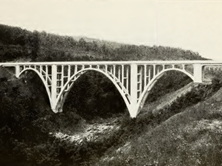 High Bridge (Henderson County Bridge 120) over Green River west of Saluda, shortly after construction in 1927 (source: Seventh Biennial Report of the State Highway Commission of North Carolina, 1927-1928).
High Bridge (Henderson County Bridge 120) over Green River west of Saluda, shortly after construction in 1927 (source: Seventh Biennial Report of the State Highway Commission of North Carolina, 1927-1928).
The reinforced concrete arch form reached its aesthetic pinnacle in the 1910s and 1920s with the open spandrel arch, which differs from the more common closed spandrel arch in that spandrel columns are used to support a deck slab rather than spandrel walls holding back earth fill.
Although open spandrels offered economy of material (less dead load) in comparison to closed spandrels, they also required more complicated formwork and were thus best suited to long-span crossings where a graceful yet powerful bridge was desired and the economy of material could be used to best advantage.
Many open spandrel arch bridges have arch rings composed of individual ribs, resulting in further economy of material.
The North Carolina State Highway Department designed open spandrel arch bridges for some prominent river crossings. The earliest was the 1917-1918 Sloan’s Ferry Bridge (no longer standing) over the Catawba River near Belmont on the Gaston-Mecklenburg county line.
The state currently has five historic open spandrel arch bridges dating from 1922 to 1930. A sixth — the 1927 High Bridge (Henderson County Bridge 120) carrying Old U.S. Route 176 over the Green River near Flat Rock — was perhaps the most impressive both in the context of its mountain setting and its engineering. Its use of asymmetrical arches for the end arch spans was an excellent solution to a difficult problem of engineering analysis and design. It was rightly considered one of the handsomest bridges in the state.